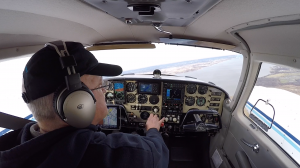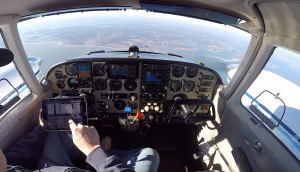Paint Repairs: I flew up to Smoketown the other day and met with Kendall at Lancaster Aero. He backed me up and gave me a great price to repair the damage to my new paint that was caused by all of the maintenance work. I was very happy to get the inspection accomplished before the snow moves in, and will wait to hear when he can fit me into the schedule.
 KILG – SBY – KMFV – KJGG: Heading down to Williamsburg today so I can get a good run on the engines. Particularly looking to keep the power up and consistent on the right engine with its new cylinder.
KILG – SBY – KMFV – KJGG: Heading down to Williamsburg today so I can get a good run on the engines. Particularly looking to keep the power up and consistent on the right engine with its new cylinder.
I turned on the heater early in the flight since it was brutally cold on the ramp. Freezing temperatures and 30 knot winds will do that. The heater worked fine, but I’m still making procedural mistakes. I should have opened the vents before I turned on the heat to ensure that the overheat sensor in the nose doesn’t trip. Once it trips, you have no heat until you land, take the nose cowl off, and hit the reset button. Fortunately I had left the right side vent open 2 years ago, since the left side was closed tight. Again – no airflow and the heater could trip off.
I lucked out and was able to test and get some use out of the heater. Once you get used to the idea of feeding aviation fuel into a can in the nose and then lighting it on fire in flight, you’ll find that the janitrol type heaters work pretty well. I’ve never had an issue with it, but you do have to remember to follow the procedures. I generally turn off the heater and leave the vents open on final to land, allowing the unit to purge and cool before the airflow slows.

The engines were running smooth on the way to Williamsburg. I had changed my destination just before departure, when I was already at the airport. That meant I didn’t have my constant wear life vest onboard, and would be crossing the water. I figured that it wouldn’t matter anyway at these temperatures and soldiered on.
The pictures included here came from the GoPro camera in the center overhead mount. No vibrations were evident in the video, and the ride was overall very smooth. The run down was at 6,500′ and gave the right engine a solid break-in hour of full power run.
Chasing Gremlins: The avionics has some gremlins in it from sitting so long. First it was the Garmin 530W ignoring button presses, but that worked itself out with the heater on and a few days of use. It’s reliable again, so now the KX-155 doesn’t tune side-bands all the time. I can pull the tuning knob out and turn all I want, but it only works every other leg. I’m sure it will start working reliably again once it used a bit more. The Aspen had a few gremlins in shut down mode where it kept going on battery when it should not. I’m sure it was my process that was doing that, because it only happened once and not again since I have been carefully observing.
I did notice that my vacuum AI that drives the autopilot was slow to erect. It didn’t get going until just prior to takeoff, probably because it was so damn cold. I’ll have to watch that though, maintain as necessary. The Garmin 496 just keeps on ticking.
The Altimatic IIIb autopilot pitch mode doesn’t work. I’ve noticed that altitude hold doesn’t even try to move the pitch trim since there is no tension on it whatsoever. Engaging Pitch control directly does add tension to the trim, but doesn’t respond to inputs. I’ll review the steps to engage and try again, but I think it needs service.
Testing the engines continues. The takeoff and ride down was super smooth and vibration free. The next leg from Williamsburg to Georgetown for fuel did have an issue. I noticed increased vibration that concerned me. Changing RPM and power settings didn’t lessen the vibration any, and directly reducing power on the right engine also didn’t help. When I reduced power on the left engine that seemed to help, but the new cylinder is on the right. I can’t draw any conclusions on this yet, but what I will do is have all of the compressions checked at the 15 hour mark, and both filters checked too.
I don’t trust my analog engine gauges any longer, and have decided to install a digital engine monitor. I’m also thinking I’ll replace these engines before I use the remaining 450 hours. Why wait until 5 years from now and THEN do them. I’m 60 years old and who knows how long I’ll be able to enjoy this.
Let’s get the autopilot working and ensure these engines are reliable for the short term.
I’ve put 6 hours on the airplane and need 9 more to get to our 15 hour target. OMG. I am so very privileged to have a nice hangar with a beautiful airplane in it, and I’m feeling it.
My work at FlightSafety already helped me pay for the rebuild, and will now help me get through the autopilot maintenance, engine analyzer install, and engine replacements. The timetable remains to be determine, but the downtime will be much much less than otherwise.
I might be thinking one or both engines at the next annual……
As for today – It’s clear but very cold out there. Low to mid 20’s at the moment, and I hate starting those engines when they are that cold. Deciding……
Fly Safe!
